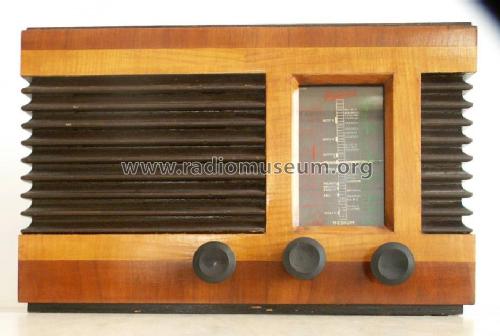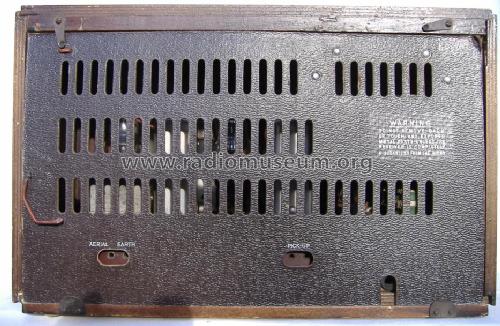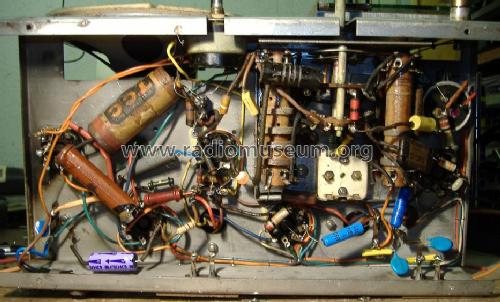Portadyne Table Model U56
Portadyne, (Brand), Dynaport Radio & Television Co. Ltd. (Whittingham Smith, Kew); London
- País
- Gran Bretaña (GB)
- Fabricante / Marca
- Portadyne, (Brand), Dynaport Radio & Television Co. Ltd. (Whittingham Smith, Kew); London
- Año
- 1945
- Categoría
- Radio - o Sintonizador pasado WW2
- Radiomuseum.org ID
- 79005
- Numero de valvulas
- 5
- Principio principal
- Superheterodino en general
- Gama de ondas
- OM, OL y OC
- Tensión de funcionamiento
- Red: Aparato AC/DC. / 210; 230; 250 Volt
- Altavoz
- Altavoz dinámico (de imán permanente) / Ø 6 inch = 15.2 cm
- Material
- Madera
- de Radiomuseum.org
- Modelo: Portadyne Table Model U56 - Portadyne, Brand, Dynaport
- Forma
- Sobremesa de cualquier forma, detalles no conocidos.
- Ancho, altura, profundidad
- 16 x 10.5 x 8 inch / 406 x 267 x 203 mm
- Anotaciones
- Walnut and maple veneered cabinet.
There is a "Gram" socket but no "gram" switch. Also the earthy end is connected to potentially live chassis by a large value wax/paper capacitor. It was probably for a "floating" crystal pickup.
- Peso neto
- 6.5 kg / 14 lb 5.1 oz (14.317 lb)
- Procedencia de los datos
- Radio! Radio!
- Autor
- Modelo creado por Konrad Birkner † 12.08.2014. Ver en "Modificar Ficha" los participantes posteriores.
- Otros modelos
-
Donde encontrará 74 modelos, 31 con imágenes y 41 con esquemas.
Ir al listado general de Portadyne, (Brand), Dynaport Radio & Television Co. Ltd. (Whittingham Smith, Kew); London
Colecciones
El modelo Portadyne Table Model es parte de las colecciones de los siguientes miembros.
Contribuciones en el Foro acerca de este modelo: Portadyne, Brand,: Portadyne Table Model U56
Hilos: 2 | Mensajes: 3
Detail of PSU under chassis

1: Wire to top of dropper from mains "live"
2: Wire from first tap on Dropper (about Mains - 10V), feeds both Anodes via 2 x 100 Ohms
12: Wire to the two dial lamps/bulbs in series across points 1 & 2
3: Wire from 210, 230 or 250 taps at bottom of dropper to start of series heater chain.
4: Neutral wire of mains to on/off switch
5: wire to Chassis from on/off switch
6. On/Off switch on rear of volume control. It's wired like this to minimise hum pickup on Audio preamp (1M pot, 10M grid resistor and high impedance detector)
7: Mains cable.
Large TCC is 8uF between chassis and 25Z6G (or 25Y5G) cathodes.
The pair of 100 Ohms feeding anodes of 25Z6G are using pin 6 (no connect) as a tag for wire to dropper and dial lamps.

Chain of 4 resistors is large green dropper vertical on top of chassis. Three bottom taps are likely 210, 230 and 250V
10V between 1 & 2
135V between 2 & top NC
21V between NC & 3
Mains is about 235V here.
Second resistor must be 450 and not 400, I wrote it down some hours after measuring and obviously remembered wrong. 300mA Series heater current.
Adding the heater voltages in data gives 68.9V. Measurement at the point (3) gives 66.5V, which is reasonable.
So assuming 2 x 6.3V 300mA dial bulbs:
There is a measured 10V, so real lamp current about 238mA.
The top section of dropper measured 110 Ohm (I unscrewed a bulb). So 91 + 238 = 329mA
The heaters are supposed to be 68.9[A*T]300mA but measure 66.5mA gives about 290mA (likely a bit more as the heaters are not linear).
This gives a possible HT current of about 39mA. We could measure the cathode current by volts on the 470 Ohms which would give g2 + anode current. Likely the g2 current is a few mA.
Michael Watterson, 07.Mar.12
Most post WWII European or UK sets appear to use a Triode/Hexode mixer/Oscillator for RF to IF. This set is quite like a 1936 to 1939 "All American Five" AC/DC design, but with dropper resistor on my example probably only for 210, 230, 250 Volts, adjusting only the heater filament series resistance in 70 Ohm (approximately) steps. Searching the tube (valve) line up in mine there are 27 models 1936 to 1940 and none later. 19 are 1936/1937. Portadyne seems to regularly used "older" technology, the "Princess" of 1956 is Octal tubes (Triode / Hexode converter) and they have a model in 1953 repeated in different case in 1956 that is a TRF! (Universal and AG33)
The live mains feeds the top of the dropper, a 110 Ohms section with two series dial bulbs (lamps) in parallel. This feeds the two 25Z6G anodes via a pair of 100 Ohm resistors using the "no connection" pin 6 of the Octal base as a tag (the cathodes are directly connected). The next section of the main dropper is about 400 to 450 Ohms for lowest mains voltage tap to series heater chain of 25Y5G (or 25Z6G), 25A6G, 6K7G, 6A8G and 6Q7G.
The on/off switch is single pole between the mains neutral and the chassis. Thus the chassis is "live" via the heater chain and "dropper" resistor when the radio is off!
For safety I removed the 20nF capacitor to top of volume control to "gram" socket "signal" and 100nF capacitor to chassis from "gram" socket "earth". The aerial and "earth" socket wax paper capacitors (2nF aerial and 20nF to chassis) were replaced with 2nF 1kV ceramic rated for X & Y use.
The wax paper capacitor across the mains in had exploded as had the first Electrolytic on 25Z6G cathodes to chassis.
A large network of 70s or 80s capacitors and resistors with modern PVC wires hung between volume control, 25A6G cathode and o/p transformer secondary. It was badly soldered and one capacitor fell off. Two wires were dry joints. This provided two feedback networks, with volume control and 6Q7G in one of them. Examining similar era schematics and the tags on the chassis suggested all of this was an addition and was removed, with only the replacement cathode resistor retained and that decoupled with 470uF 63V that had been wired from cathode to speaker.
After replacing the obviously exploded capacitors, fixing wiring to more likely and replacing other virtually short wax paper capacitors the radio operates much as I'd expect. There is a short wire connected to the heat shield on rear cover (for dropper) which functions as an aerial for very strong stations. The set performs reasonably with 3m indoor wire and very well with a longer outdoor wire (washing line!).
Michael Watterson, 07.Mar.12






